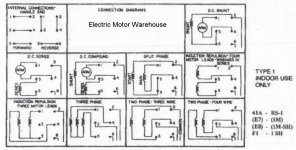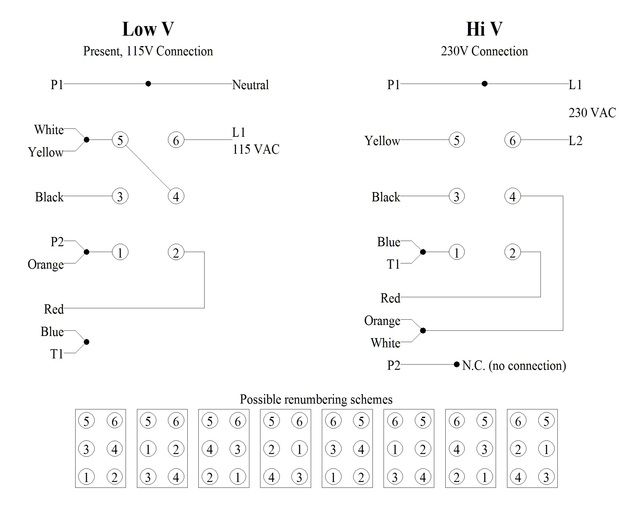projectnut
Stainless
- Joined
- Mar 4, 2006
- Location
- Wisconsin
I know this subject has been discussed several times in the past. However I can't find a diagram that matches the particular motor and switch I am trying to configure.
The motor is a Marathon 120/240 volt, single phase, 1 hp, reversible. The drum switch is a Relay and Controls Corp. RS-1. I have attached picture of the wiring diagram as it appears inside the switch cover
In this case the motor has manual a overload and 9 wires. According to the wiring diagram when wiring the motor to 220 volts 8 of the 9 need to be connected to the switch. The 9th wire is insulated and left unconnected. I am providing a link to the wiring diagram at the Marathon website since the pdf file is too large to post as an attachment
I have been running this motor and switch combination in the low voltage mode for nearly 20 years. I recently installed several 220 volt single phase circuits and would like to switch the motor to the higher voltage.

Motor Wiring Diagram:
http://www.marathonelectric.com/CnxDocRequest/PublishedPDF/102005_52_52390_365.pdf
Any help would be appreciated.
The motor is a Marathon 120/240 volt, single phase, 1 hp, reversible. The drum switch is a Relay and Controls Corp. RS-1. I have attached picture of the wiring diagram as it appears inside the switch cover
In this case the motor has manual a overload and 9 wires. According to the wiring diagram when wiring the motor to 220 volts 8 of the 9 need to be connected to the switch. The 9th wire is insulated and left unconnected. I am providing a link to the wiring diagram at the Marathon website since the pdf file is too large to post as an attachment
I have been running this motor and switch combination in the low voltage mode for nearly 20 years. I recently installed several 220 volt single phase circuits and would like to switch the motor to the higher voltage.

Motor Wiring Diagram:
http://www.marathonelectric.com/CnxDocRequest/PublishedPDF/102005_52_52390_365.pdf
Any help would be appreciated.






